I am not sure why, but I’ve always liked “run your own casino” type games. Casino, Inc. for the PC is among my favorites, even though it suffers from quite a few flaws. I was watching Frasier the other night when the thought popped into my head…”Hey, I’ve been reviewing a lot of board games lately, maybe there’s a readily available casino themed game out there? TO AMAZON!!!” I must have said that last part out loud, based on the looks my dog and two cats gave me. After a little research, I went ahead and ordered this game, hoping for the best.
Lords of Vegas is indeed full of theme…the board by itself is very eye-catching. The playing pieces each player receives are in the form of dice and clear plastic tokens. There is paper money as well…though I think casino chips would have been more thematic and overall awesome. I suppose production values have to be capped off somewhere, right?
The object of the game is to have the most victory points at the end of the game. Pretty simple so far. Let’s take a look at the game components, just so that you’re not scratching your head as I’m explaining the rules.
Components
Dice – There are twelve dice of each player color. Players will be using these to indicate that they own a casino on the playing board. The pips on the die represent a number of things…like figuring out how much a player receives when that casino pays out and who is the “boss” of the entire casino if different colored die occupy the same colored, adjacent casinos. More on that in a bit.
Markers – There are clear, plastic markers that players use to indicate which lots they own. Players who own lots can build casinos there, at the price listed on the board in that location. Players also receive a small income from lots.
Casinos – There are squared, donut themed pieces that fit in the spaces on the board. The hole in the middle of the piece is where the player die goes, indicating who owns it. Casinos come in various colors…these colors have NOTHING to do with player colors, rather, they are used to determine which casino pays out when a particular colored property card is drawn.
Property Cards – These cards are made up of different colors, indicating which casino color will pay out when it is drawn. The player who draws the card gets to place a marker on that lot, indicating that they now own it for possible future expansion into a casino. Cards do other things as well, but I’ll let the rules section explain that.
Scoring Chips – Each player has a large, solid colored scoring chip that they move along the track that borders the playing board. These help players keep track of their victory points as they earn them throughout the game.
Action Cards – This card serves as a guide to remind players on what they can do on their turn.
Now that you have a rough idea of what everything is, let’s take a look at the rules and gameplay mechanics.
Game Setup
1. Players choose a color. They receive their respective colored dice and markers. Scoring markers go right above the ”1″ on the scoring track as there is no “0.”
2. Players receive two property cards. Players receive the money listed on those cards as their “starting money.” They will also place markers on the lots indicated on the cards. The cards are then discarded into separate colored piles, preferably in a way that shows how many of a particular color has been drawn. This helps players determine the likelihood of that color being drawn again as the game progresses.
3. Place the end of game card about 3/4 of the way into the deck. When this card is drawn, a final “strip” payout occurs and the game is over.
4. Players roll two die to determine the starting player. Play proceeds clockwise from there until the game over card is drawn.
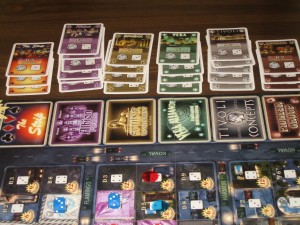
In this example, brown property cards were drawn the least amount of times. This increases their chance of being drawn at a future date. Players therefore may want to consider buying a brown casino or two.
Player Turns
1a. The current player draws one new property card. This player places a marker on the lot indicated on the card.
1b. ANY lot on the board pays $1m to their owner. This does not include casinos.
1c. The casinos of the color matching the card drawn receive money. The amount of money the owner of the casino gets depends on the number of pips showing on the die at that location. $1m per 1 die pip.
1d. The boss of those casinos mentioned in 1c get victory points. The boss is the person with the highest pip value when compared to adjacent casinos of the same color. If two brown casinos border each other and the red player has a 5 and the blue player has a 3, red is the boss of those two casinos. The boss receives 1 VP per adjacent casino tile.
Strip Cards – If a strip card is drawn instead of a property card, all casinos along the strip (the middle street) pay out money according to their pip value and VPs to the bosses of those casinos using the same rules as 1c and 1d.
The Scoring Track – Players will notice that the scoring track jumps numbers. In order for players to advance their token at these locations, you have to score that many VPs in one sitting to move up. This encourages players to build larger casinos and to be the boss of those casinos so that they can get more VPs at once.
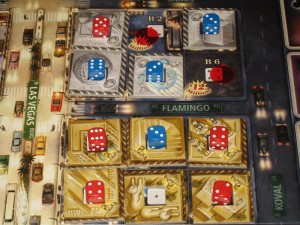
Being the boss of large casinos is key to moving along the victory point track. In this example, the red player is the boss of the yellow casino and would net 6 VPs if a yellow property card was drawn. Blue would still earn $3m for owning one of those yellow casinos, while red would earn $16m + 6 VPs.
Once the above events have been resolved, that player can take actions. They may take as many actions as they want, as many times as they want, with the exception of the gamble action. If you run out of dice, you can remove an existing one to play the new action, leaving the casino tile there representing that it is now vacant. The boss of that casino tile from adjacent, owned casinos can still score VPs off of it, however.
2a. Build – Replace your lot marker with a casino color of your choice. Place a die in the middle of the casino, using the same pips as shown on the board. The cost is indicated on the bottom left of that space.
2b. Sprawl – (BOSS ACTION ONLY) Build a casino on an unowned lot next to one of your owned casinos. The color is the same as the owned casino and the cost is double that of what is indicated on that space. This can be risky…if a different player draws that card from the deck, they replace their die with your own and you lose ownership of your investment automatically. The game over card is 3/4 of the way through the deck so it’s possible that the location you sprawl may not come up.
2c. Remodel – (BOSS ACTION ONLY) Pay $5 per tile to change the color of a casino, even if another player owns it…after all, you ARE the boss.
2d. Reorganize – Pick a casino, pay $1 per pip per die, and re-roll their numbers. You have to have at least one die in the location you are reorganizing. You can only roll a particular die once per turn, despite being able to perform multiple reorganizations. After re-rolling, dice go back into the spots they came from, though if you have more than one color, you can pick which die goes in which casino space.
2e. Gamble – Once per turn, the current player picks a casino of which another player is boss, bets, and rolls two dice. The current player can bet up to $5 per casino tile. Before the roll, the boss may “lay off” half of his bet…examples to follow. If the current player rolls a 2, 3, 4, 9, 10, 11, or 12, they win…double if a 2 or 12 is rolled.
Example 1) Current player bets $10. Boss sees the bet. If current player wins, they get $20, doubling their money. If the boss wins, they get the $10 that was bet.
Example 2) Current player bets $10. Boss lays off half…meaning the boss sees the bet by $5 and the bank sees the bet by $5. If the current player wins, they get $20, doubling their money, $10 from the bet, $5 from the bank, and $5 from the boss. If the boss wins, $5 goes to the boss and the other $5 goes to the bank.
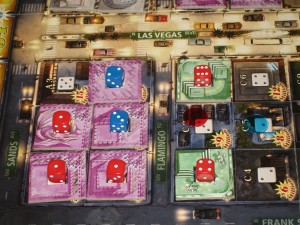
It would be wise of red to reorganize the purple casino…it would be cheap (low amount of pips) and they have a better chance of being the boss (3 red dice vs 2 blue dice).
The Review
I am sure I missed a rule or two but the above should give you an idea of what you are in for. I’m fairly pleased with the quality of the components however I scratched my head at the box insert / tray. No matter how many different ways I tried laying out the components, it just didn’t “seem” right. Either the tray was designed by someone who’d been sniffing paint for five hours straight or I’ve been playing so many board games lately that I’ve become both senile and delirious.
The manual was a bit confusing at times. There were five casino tiles that looked similar to their “brethren” but were plain in color and had a graphic on them. I have no idea what they are used for and I couldn’t find anything in the manual. My best guess was that they were category tokens of some kind…but who knows for what. I was also a bit confused by what players can actually do with a vacant casino, which results when a player must use an existing die to build a new casino. Do players have the option to re-buy it? Can an opponent buy it out at normal price or must they sprawl into it at double the cost? I couldn’t find a mention of this in the manual either, so I just invented by own rules. If anyone knows the answers to these questions, please leave a comment below.
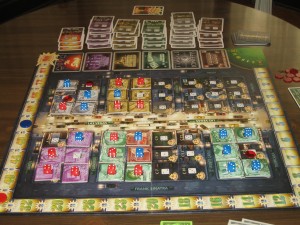
While we’re on the subject of miscellaneous rules, the two player variant doesn’t use the “F” block lots. If one is drawn, $ and VPs are scored as normal but the same player draws again and takes a regular turn. Think of the “F” block cards as a bonus payout.
I turned to this video to help me understand some of the other mechanics better:
Overall, the game was a lot of fun to play. Vinnie Jr, my eleven year old son, claimed that his favorite part was figuring out which properties to buy and what colors to use to get the most money and points. He complained at the start because his income was low, but as the game progressed he saw how good planning could rake in a steady income, assuming that the property cards were being nice to him. There’s a little luck involved with what colors are drawn but the laws of probability are the same throughout the galaxy. He ended up winning the game, having monopolized a few 5-6 VP casinos. I attempted to reorganize regularly to change-up who was boss but the dice were particularly cruel to me this time around. By the time I got the dice to agree with me, the game over card was drawn.
It’s worth noting that we didn’t trade or gamble once…we were so engrossed with strategizing over the colors that we neglected that aspect of the game. The game took us about a total of ninety minutes, including setup and some pauses for the occasional rule clarification. It’s hard to compare this game to anything I have in my collection…though I suppose it could be the bastard spawn of Monopoly and Acquire…sort of.
Final Verdict: 7/10
—
http://www.youtube.com/watch?v=E6wb2HZbzNM

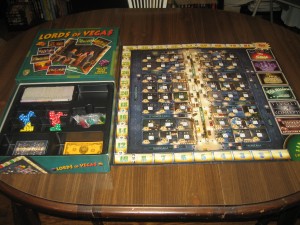
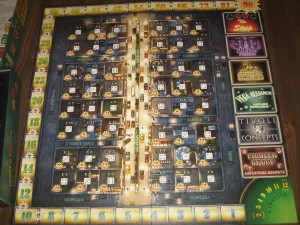
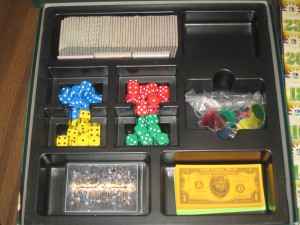
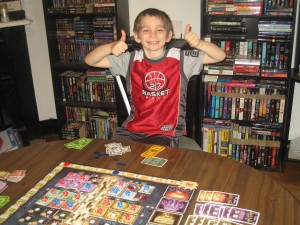
The plain casino tiles appear to be extras. On the first page of my rule insert, it says, “* The 10th tile can be used as a replacement.” Also my box tray is slightly different and even less well thought out.
Just a comment on a rule you have incorrect in your video.
When you are discussing how to determine the boss of a casino, you use the example of the 1 red, 2 blue and 1 yellow die. Although the blue and yellow die are adjacent (or chained as you said), they are different colored casinos and therefore are not considered a single casino. They are 3 separate casinos, meaning each of those die are the boss of their own size 1 casino. So in your example, red and blue would both score 1 each.
Thanks, I added a quick note to the video.
If you like “build casino” games in this vein you should also pick up “Vegas Showdown” which is still widely available and cheap. Highly recommend that in addition to this one. In Vegas Showdown you are bidding on various Components to link together on a hotel map layout to literally build a profitable casino